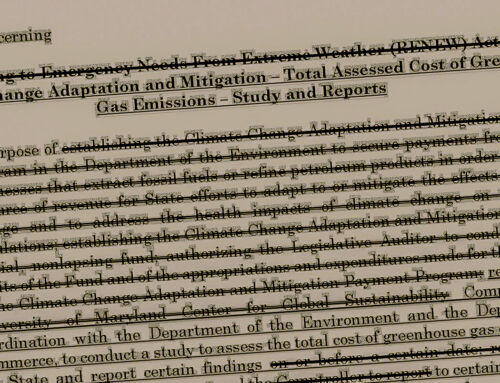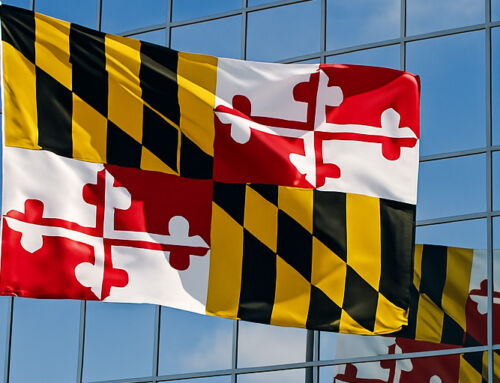View by Topic
Recent Articles
-
New Environmental Laws from the 2025 Maryland Legislative SessionSaturday, April 26th, 2025
-
Migratory Bird Treaty Act Does Not Prohibit Incidental Take – AgainSaturday, April 19th, 2025
-
President Trump’s Bold Step to Rein in State Overreach in Climate ChangeSaturday, April 12th, 2025
-
Mandatory GHG Disclosures in Maryland Real Estate ContractsSaturday, April 5th, 2025
View by Month/Year
“Green Building Law Update” Headlines
Recent Articles & News from
Stuart Kaplow’s blog
at GreenBuildingLawUpdate.com
- BEPS Redux: The Most Far Reaching Environmental Legislation of the 2025 Maryland General Assembly May 4, 2025
- New Environmental Laws from the 2025 Maryland General Assembly Session April 27, 2025
- Migratory Bird Treaty Act Does Not Prohibit Incidental Take – Again April 20, 2025
- President Trump’s Bold Step to Rein in State Overreach in Climate Change April 13, 2025
Subscribe to the Green Building Law Update!
Stuart Kaplow brings his expertise and extensive experience to the table with his unique digital publication, "Green Building Law Update". Subscribers receive regular updates to keep them informed about important issues surrounding Environmental Law, Green Building & Real Estate Law, as well as the emerging demand for Environmental Social Governance (ESG).
Get fresh content through the lense of Stuart Kaplow's cutting-edge expertise, innovative commentary and insider perspective. Don't miss another issue! Subscribe below.

NYC Building Electrification Ruling is Interesting But Not a Game Changer
On March 18, 2025, a federal judge in the Southern District of New York handed down a ruling in Association of Contracting Plumbers of the City of New York, Inc. et al. v. City of New York, dismissing a challenge to New York City’s Local Law 154 of 2021. This law, often dubbed the New York City Building Electrification Law, prohibits fossil fuel combustion in most new residential buildings, pushing the city toward an all electric future as part of its carbon neutrality goals. Industry groups and a plumbers’ union argued that the federal Energy Policy and Conservation Act (EPCA) preempted the law, claiming it encroached on federal authority over energy standards. Judge Ronnie Abrams disagreed, upholding the City’s authority and dismissing the case with prejudice. Her honor was likely wrong.
At first glance, this decision might seem like a landmark victory for state and local governments aiming to decarbonize buildings. However, while the ruling is certainly interesting and a win for New York City government, it doesn’t set any sweeping precedent for similar efforts nationwide. Instead, it highlights the specific limits of EPCA’s preemption clause and underscores that climate some focused building laws, like Local Law 154, can coexist with federal law when carefully tailored.
Let’s unpack why this ruling is more of a nuanced clarification than a transformative legal shift, particularly in the context of what sounds like last year’s and now passed bad idea of all electric buildings, in this instance targeting only new construction and not existing buildings.
What Local Law 154 Actually Does
Before diving into the ruling, it’s worth clarifying what Local Law 154 entails. Enacted in December 2021, the law prohibits the combustion of substances emitting 25 kilograms or more of carbon dioxide per million British thermal units in new residential buildings. This effectively bans fossil fuel powered appliances, like gas stoves, furnaces, and water heaters, in new construction, with phased implementation: buildings under seven stories must comply by January 1, 2024, and taller buildings by July 2, 2027. Importantly, the law applies only to new construction, leaving existing buildings untouched. It also includes exceptions for specific uses, such as commercial kitchens and hospitals, ensuring flexibility where electrification might be impractical.
The plaintiffs, representing plumbing and construction trades reliant on fossil fuel systems, argued that this ban “concerns” the “energy use” of EPCA regulated appliances by reducing their energy consumption to zero, thus conflicting with federal authority. The City countered that the law regulates fuel types at the building level, not appliance performance, placing it outside EPCA’s scope.
The Court’s Reasoning: A Narrow Take on EPCA
Judge Abrams’ 16 page opinion is a masterclass in parsing legalese, interpreting EPCA, a 1975 statute designed to set uniform energy conservation standards for appliances like furnaces and ovens. EPCA preempts state and local regulations “concerning the energy efficiency, energy use, or water use” of these “covered products” when federal standards are in place (42 U.S.C. § 6297(c)). The plaintiffs leaned on this clause, pointing to a 2023 Ninth Circuit decision (California Restaurant Association v. City of Berkeley) that struck down Berkeley’s ban on natural gas piping in new buildings, arguing it effectively nullified the “energy use” of gas appliances.
Abrams rejected this broad reading. She defined “energy use” under EPCA as a fixed, pre-market metric, the amount of energy an appliance consumes under standardized test conditions, not its real world operation. Local Law 154, she reasoned, doesn’t touch this metric. It doesn’t dictate how efficient an appliance must be or how much energy it can use as manufactured. Instead, it restricts the type of fuel available to appliances in new buildings, a regulatory choice that operates downstream of EPCA’s focus on appliance design and performance. This distinction was dispositive: the law “does not draw any distinction between products based on their energy efficiency or energy use as manufactured,” but rather “regulates, indirectly, the type of fuel that a covered product may consume in certain settings.”
The key holding here is likely that Local Law 154 is not preempted by EPCA because Local Law 154 neither “concerns” nor “relates to” the “energy use” of covered applianc under EPCA.
The judge also contrasted Local Law 154 with Berkeley’s ordinance. While Berkeley banned gas piping outright, New York City’s law sets an emissions threshold that indirectly discourages fossil fuels without prohibiting infrastructure. This subtlety helped Abrams sidestep the Ninth Circuit’s logic, which tied preemption to end user ability to operate appliances. She further noted that EPCA’s purpose, ensuring uniform national standards to ease manufacturer burdens, isn’t thwarted by Local Law 154, which imposes no new design requirements and aligns with traditional municipal authority over building codes.
It’s a brainy, nuanced take that will keep law professors buzzing.
Why This Isn’t a Broad Precedent
The ruling’s intrigue lies in its surgical dissection of EPCA, but it cannot in any meaningful way reshape the legal landscape for state and local electrification efforts. Here’s why:
1. Case Specific Context: The decision is tethered to Local Law 154’s unique structure, an emissions based restriction on fuel combustion, not a direct appliance or infrastructure ban. Other jurisdictions with different approaches (e.g., Berkeley style gas bans) might still face EPCA challenges, as will BEPS laws across the country that are a different animal altogether. Abrams explicitly disagreed with the Ninth Circuit’s interpretation, setting up a potential circuit split ( and dream of a U.S. Supreme Court ruling some day, but this ruling binds only the Southern District of New York unless affirmed by the Second Circuit on appeal.
2. Limited Scope New Construction Only: Local Law 154 applies solely to new buildings, a small fraction of the housing stock (about 0.2% annually in New York State, per some estimates). This narrow focus reduces its relevance to broader electrification efforts targeting existing buildings, where retrofitting fossil fuel systems poses bigger legal and practical hurdles. EPCA’s preemption might loom larger in challenges to laws mandating appliance replacements in older structures, an issue this case doesn’t address.
3. Municipal Authority Isn’t Novel: The decision reaffirms what many already assumed: states and localities can regulate building codes and fuel use under their traditional powers, as long as they don’t set appliance efficiency standards. Abrams pointed to existing city codes, like bans on kerosene heaters or unvented furnaces, as evidence that such regulations predate and survive EPCA. This isn’t a new legal frontier; it’s a validation of established practice.
4. No Universal Blueprint: While the ruling bolsters confidence in emissions based approaches, it doesn’t guarantee success for all climate focused building codes. Jurisdictions must still craft laws that avoid directly regulating EPCA covered appliances’ “energy use” or “efficiency” as defined. By way of example, Building Energy Performance Standards, including the one in Maryland, will trip over federal preemption, because across the country, BEPS mimic Berkeley’s direct pipeline ban rather than New York’s indirect fuel restriction.
Clarifying EPCA’s Limits
The real value of this ruling lies in its clarification of EPCA’s boundaries. It confirms that the statute’s preemption is narrow, targeting regulations that interfere with appliance performance standards, not broader building level policies. Local Law 154 sidesteps this by focusing on fuel combustion, a choice tied to climate and air quality goals, rather than dictating how appliances function.
That said, the ruling doesn’t resolve many uncertainties. The plaintiffs plan to appeal to the Second Circuit, and the higher court may, and some suggest, likely will adopt a different view. Meanwhile, the Ninth Circuit’s Berkeley decision still chills gas bans in western states, creating a patchwork of legal realities. For now, though, Abrams’ opinion suggests that EPCA isn’t the insurmountable barrier some suggested, especially for new residential construction only mandates like New York’s.
The Bigger Picture
For climate hawks, the ruling is a win. NYC’s electrification push lives to fight another day. But it’s not a golden ticket for every state or city looking to regulate energy.
The ruling is a compelling read and a small victory for local climate policy, but it’s not the Rosetta Stone for decoding EPCA’s role in the electrification revolution. It’s a single data point, not a floodgate. As Blue states and cities keep pushing climate based building regulation, expect more courtroom showdowns to truly map the federal state turf war over climate action. For now, NYC’s new construction ban stands, but the pendulum has already swung away from global warming regulation. The bigger fight is far from over.
_________________________
Join us for the next in our “carbon based life form” webinar series, “Mandatory GHG Disclosures in Maryland Real Estate Contracts” on Tuesday, April 8 from 9 – 9:30 am. The webinar is complimentary, but you must register here.









